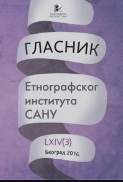Цинцари у Yрошевцу и другим „косовским железничким варошима“ — Прилог историји Цинцара у Србији —
Tzintzars in Uroševac and Other Kosovo’ Rail Centers — a contribution to the history of Tzintzars in Serbia —
Author(s): Miloš LukovićSubject(s): Recent History (1900 till today), Cultural Anthropology / Ethnology, Ethnic Minorities Studies, Socio-Economic Research
Published by: Етнографски институт САНУ
Keywords: Tzintzars; settling; Kosovo; railroad; trade; displacement;
Summary/Abstract: A relatively large number of Tzintzars used to live in Uroševac for more than 120 years, until they got totally displaced in 1999. The Tzintzars also lived in other Kosovo towns: Lipljan, Obilić, Pristina and Kosovska Mitrovica, until hazardous living conditions compelled them to relocate to Vučitm and Kačanik. Vučitrn and Kačanik were trade centers located near the railroad (that stared to operate in 1873) and, as such, represented attractive locations with numerous possibilities for profit and earnings (that is why J. Cvijić called these settlements „railroad towns“). Hence, in a few waves, the Tzintzars that inhabited the mountain zone of Bitolj-Kruševo (Gopeš, Magarevo, Nižopolje, Malovište), and even Bitolj, Kruševo and nearby Prizren, started to settle in this region. The relationship with the parent country was maintained by marriage and permanent contact. For a long time, the Tzintzar language was in use, and ethnic identity preserved. The Tzintzars left a considerable mark on the Kosovo economy and culture. Their occupations, like trade (especially grain purchase and its delivery, via railroad to Skoplje, Thessalonica, and other places along the way), handicrafts, hostelry and tavern- owning, enabled them to participate in the founding of new towns: Ferizović (Uroševac), Lipljan, Globoderice (Obilić); and, at the same time, to reinforce economies in Pristina and Kosovska Mitrovica. In the interwar period, already ramified Tzintzar lineages extended their economic activities (in the milling industry, banking, agriculture, the commencement of industry), started to send their children to academies and better schools and supported social institutions in their settings. After World War II, following the nationalization o f their property, the Tzintzars were forced to hastily change their traditional occupations — thus they started to relocate, mostly to Skoplje. This was a typical outcome for many of the Tzintzar lineages. To illustrate this occurrence, we choose to present in detail the genealogy and history of the lineage Nikolić, from Uroševac. The given data about Tzintzars in Kosovo ravine should add to our knowledge of the general history of Tzintzars from Serbia.
Journal: Гласник Етнографског института САНУ
- Issue Year: LII/2004
- Issue No: 1
- Page Range: 165-185
- Page Count: 21
- Language: Serbian

